Coffee chain Dutch Bros (NYSE:BROS) reported Q1 CY2024 results beating Wall Street analysts' expectations, with revenue up 39.5% year on year to $275.1 million. The company expects the full year's revenue to be around $1.21 billion, in line with analysts' estimates. It made a non-GAAP profit of $0.09 per share, improving from its loss of $0.02 per share in the same quarter last year.
Dutch Bros (BROS) Q1 CY2024 Highlights:
- Revenue: $275.1 million vs analyst estimates of $255.6 million (7.6% beat)
- Adjusted EBITDA: $52.5 million vs analyst estimates of $31.7 million (large beat)
- EPS (non-GAAP): $0.09 vs analyst estimates of $0.02 ($0.07 beat)
- The company lifted its revenue guidance for the full year from $1.20 billion to $1.21 billion at the midpoint, a 0.8% increase (also lifted its adjusted EBITDA guidance for the full year)
- Gross Margin (GAAP): 26.1%, up from 23.2% in the same quarter last year
- Same-Store Sales were up 10% year on year
- Store Locations: 876 at quarter end, increasing by 160 over the last 12 months
- Market Capitalization: $2.64 billion
Started in 1992 by two brothers as a single pushcart, Dutch Bros (NYSE:BROS) is a dynamic coffee chain that’s captured the hearts of coffee enthusiasts across the United States.
Since day one, the Dane brothers, founders of the Oregon-based company, set out to create not just any coffee shop but a community-driven brand that’d be known for its vibrant energy. This is seen in its distinctive blue stands, which are staffed by enthusiastic baristas known as "broistas”.
Combined with the upbeat atmosphere stirred up by the broistas, the company leverages a unique model to serve its customers. For Dutch Bros, the drive-thru is the main mode of coffee delivery as the average stand is around 950 square feet, roughly the size of a studio apartment, and only has outdoor seating. This approach reduces wait times and enables the company to serve a high volume of customers.
Dutch Bros has over 700 locations across the United States and offers a wide range of beverages at its stands, from traditional lattes and mochas to innovative creations like the Dutch Freeze.
Given its focus on the customer experience, Dutch Bros has also built a digital presence. Vintage photos featuring Chicago landmarks, celebrities, or pop culture line the walls to remind everyone of the restaurant’s roots. Customers can sign up for the company’s mobile app to order ahead and earn rewards. Dutch Bros is also active on social media platforms like TikTok, further bolstering their reputation as the “fun” brand.
Traditional Fast Food
Traditional fast-food restaurants are renowned for their speed and convenience, boasting menus filled with familiar and budget-friendly items. Their reputations for on-the-go consumption make them favored destinations for individuals and families needing a quick meal. This class of restaurants, however, is fighting the perception that their meals are unhealthy and made with inferior ingredients, a battle that's especially relevant today given the consumers increasing focus on health and wellness.
Some competitors that sell caffeinated beverages include private company Dunkin’ as well as public companies McDonald’s (NYSE:MCD), Starbucks (NASDAQ:SBUX), and Tim Hortons (owned by Restaurant Brands, NYSE:QSR).Sales Growth
Dutch Bros is larger than most restaurant chains and benefits from economies of scale, giving it an edge over its smaller competitors.
As you can see below, the company's annualized revenue growth rate of 42.3% over the last four years (we compare to 2019 to normalize for COVID-19 impacts) was incredible as it added more dining locations and increased sales at existing, established restaurants.
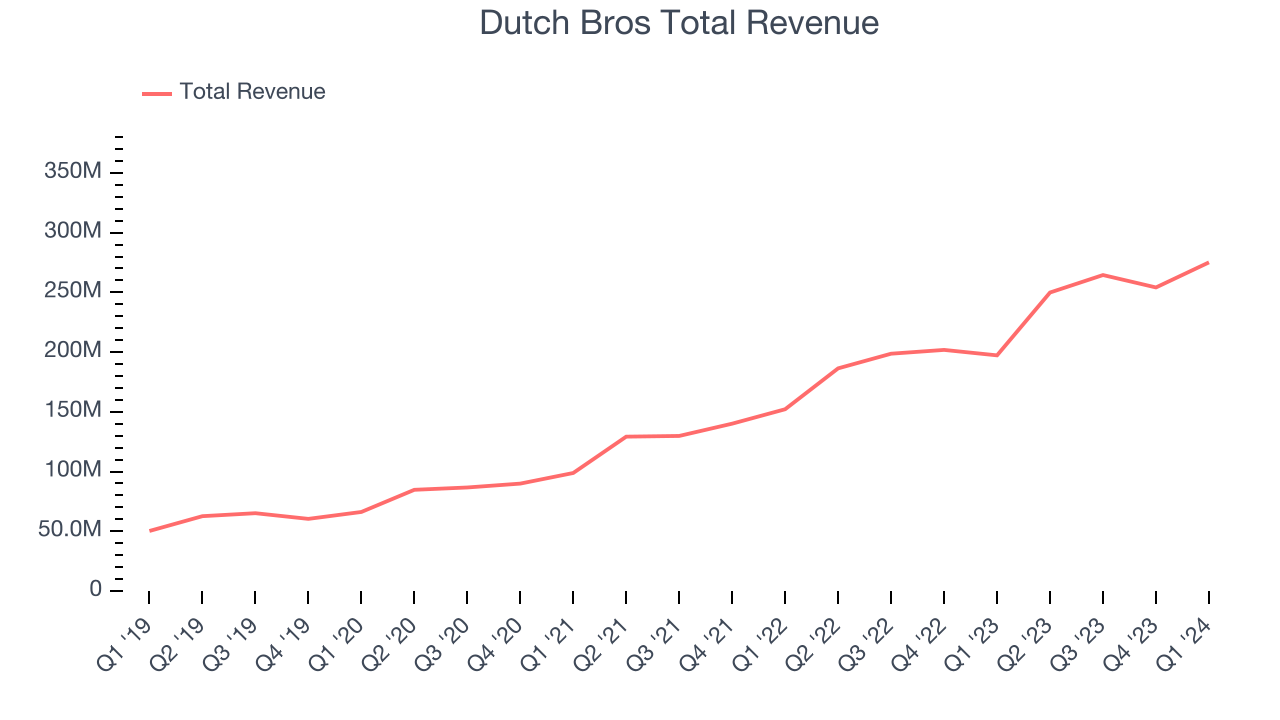
This quarter, Dutch Bros reported wonderful year-on-year revenue growth of 39.5%, and its $275.1 million in revenue exceeded Wall Street's estimates by 7.6%. Looking ahead, Wall Street expects sales to grow 21% over the next 12 months, a deceleration from this quarter.
Same-Store Sales
A company's same-store sales growth shows the year-on-year change in sales for its restaurants that have been open for at least a year, give or take. This is a key performance indicator because it measures organic growth and demand.
Dutch Bros's demand within its existing restaurants has been relatively stable over the last eight quarters but fallen behind the broader sector. On average, the company's same-store sales have grown by 2.3% year on year. With positive same-store sales growth amid an increasing number of restaurants, Dutch Bros is reaching more diners and growing sales.
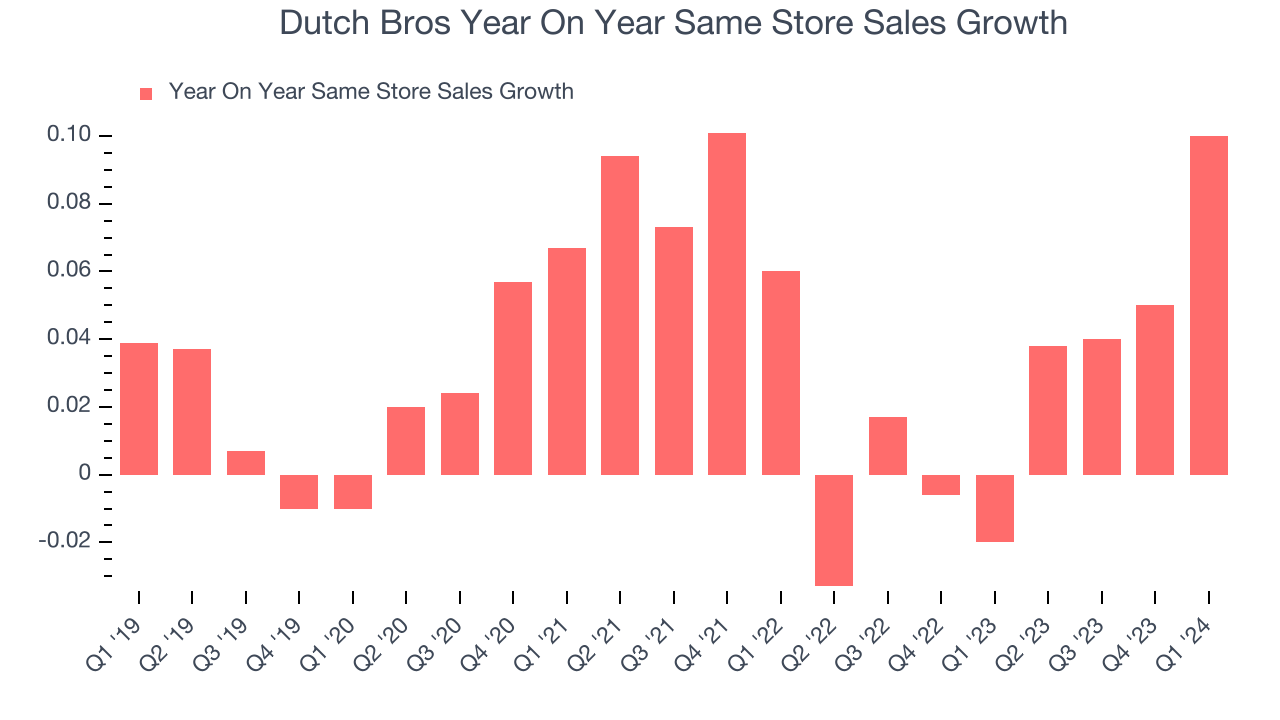
In the latest quarter, Dutch Bros's same-store sales rose 10% year on year. This growth was a well-appreciated turnaround from the 2% year-on-year decline it posted 12 months ago, showing the business is regaining momentum.
Number of Stores
A restaurant chain's total number of dining locations is a crucial factor influencing how much it can sell and how quickly company-level sales can grow.
When a chain like Dutch Bros is opening new restaurants, it usually means it's investing for growth because there's healthy demand for its meals and there are markets where the concept has few or no locations. Since last year, Dutch Bros's restaurant count increased by 160, or 22.3%, to 876 locations in the most recently reported quarter.
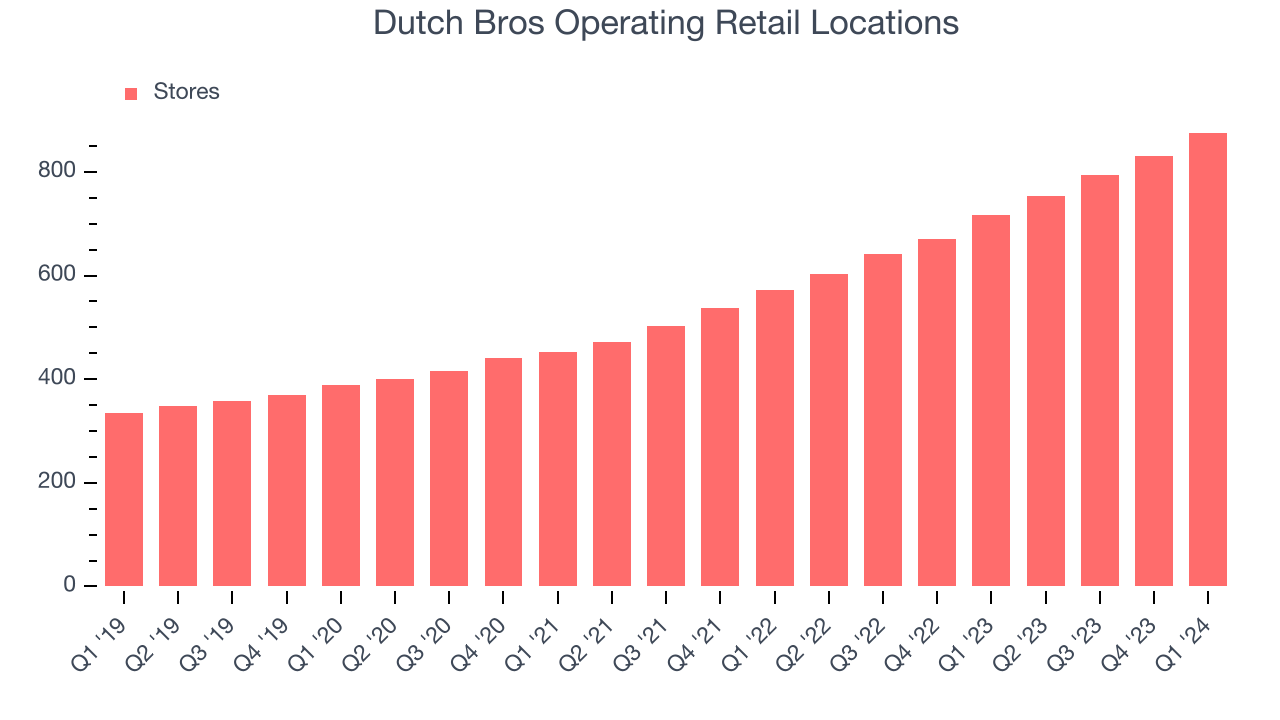
Taking a step back, Dutch Bros has rapidly opened new restaurants over the last eight quarters, averaging 25.1% annual increases in new locations. This growth is much higher than other restaurant businesses. Analyzing a restaurant's location growth is important because expansion means Dutch Bros has more opportunities to feed customers and generate sales.
Gross Margin & Pricing Power
Dutch Bros's gross profit margin came in at 26.1% this quarter. up 2.9 percentage points year on year. This means the company makes $0.26 for every $1 in revenue before accounting for its operating expenses.
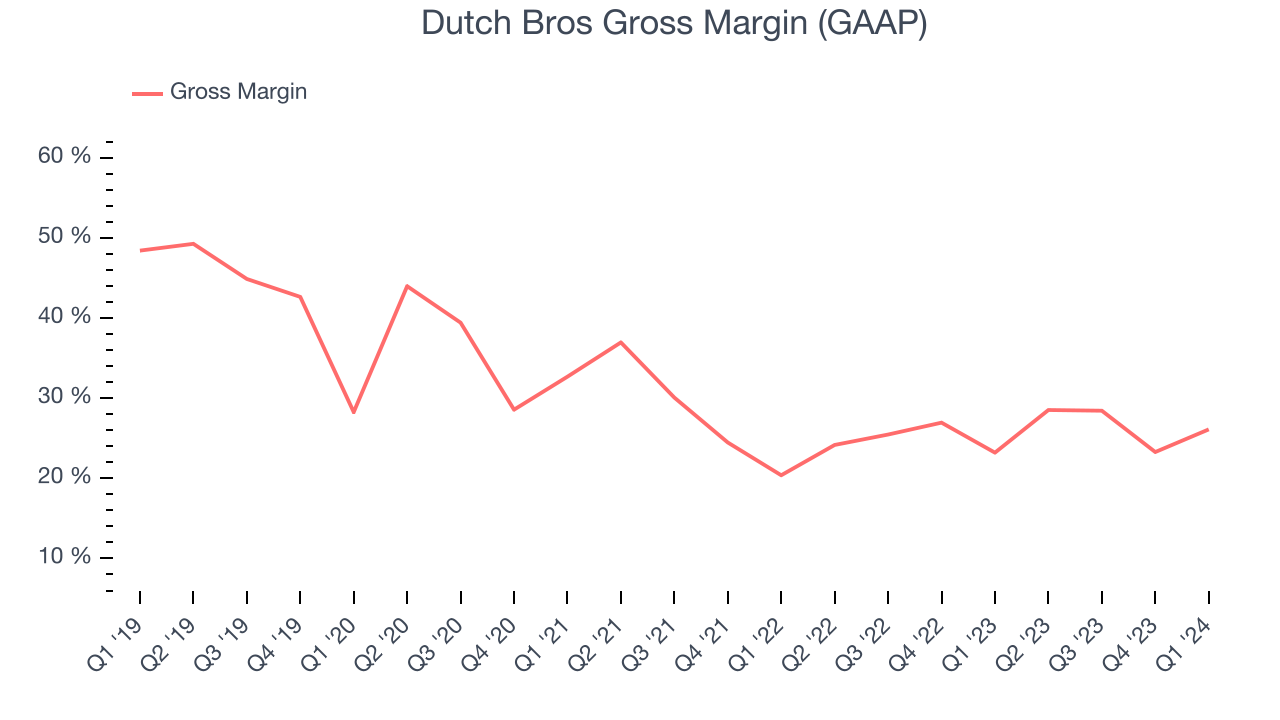
Dutch Bros's unit economics are higher than the typical restaurant company, giving it the flexibility to invest in areas such as marketing and talent to reach more consumers. As you can see above, it's averaged a decent 25.9% gross margin over the last eight quarters. Its margin has also been trending up over the last 12 months, averaging 7.2% year-on-year increases each quarter. If this trend continues, it could suggest a less competitive environment where the company has better pricing power and more stable input costs (such as ingredients and transportation expenses).
Operating Margin
Operating margin is a key profitability metric for restaurants because it accounts for all expenses keeping the lights on, including wages, rent, advertising, and other administrative costs.
In Q1, Dutch Bros generated an operating profit margin of 9.3%, up 9.4 percentage points year on year. This increase was encouraging, and we can infer Dutch Bros was more disciplined with its expenses or gained leverage on its fixed costs because its operating margin expanded more than its gross margin.
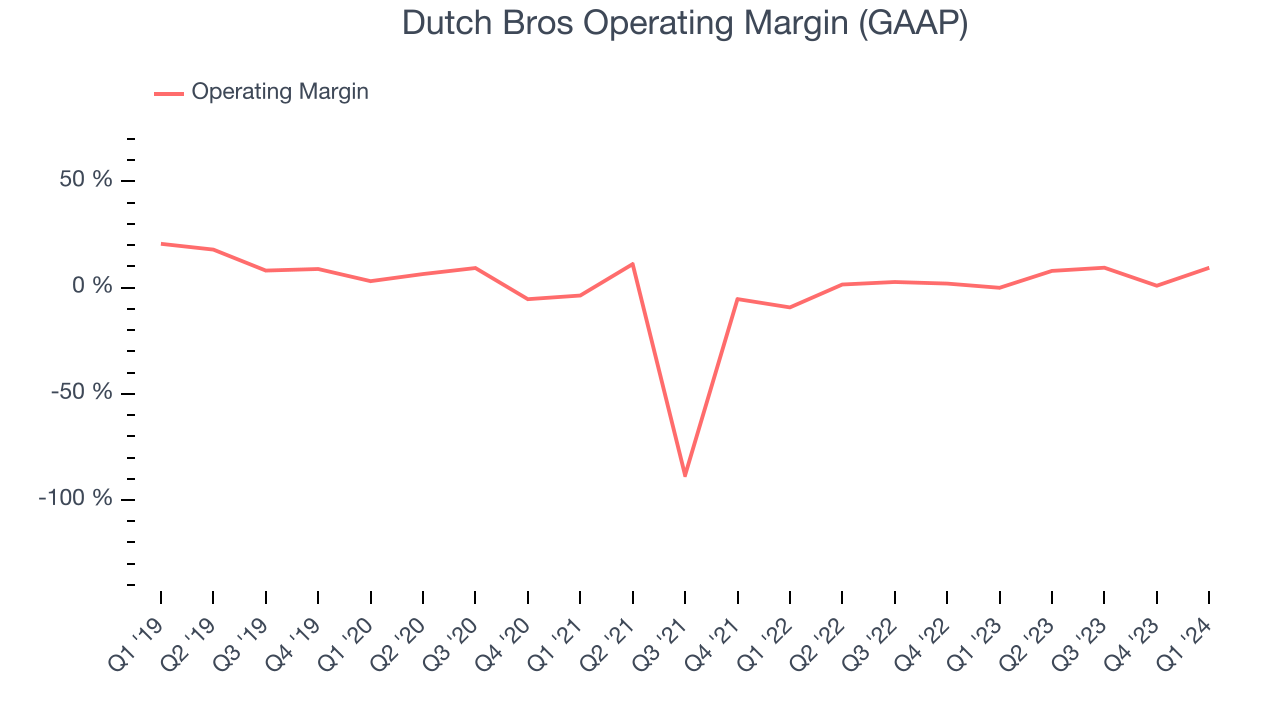 Zooming out, Dutch Bros was profitable over the last eight quarters but held back by its large expense base. It's demonstrated subpar profitability for a restaurant business, producing an average operating margin of 4.6%. However, Dutch Bros's margin has improved, on average, by 5.5 percentage points each year, an encouraging sign for shareholders. The tide could be turning.
Zooming out, Dutch Bros was profitable over the last eight quarters but held back by its large expense base. It's demonstrated subpar profitability for a restaurant business, producing an average operating margin of 4.6%. However, Dutch Bros's margin has improved, on average, by 5.5 percentage points each year, an encouraging sign for shareholders. The tide could be turning.EPS
Earnings growth is a critical metric to track, but for long-term shareholders, earnings per share (EPS) is more telling because it accounts for dilution and share repurchases.
In Q1, Dutch Bros reported EPS at $0.09, up from negative $0.02 in the same quarter a year ago. This print easily cleared Wall Street's estimates, and shareholders should be content with the results.
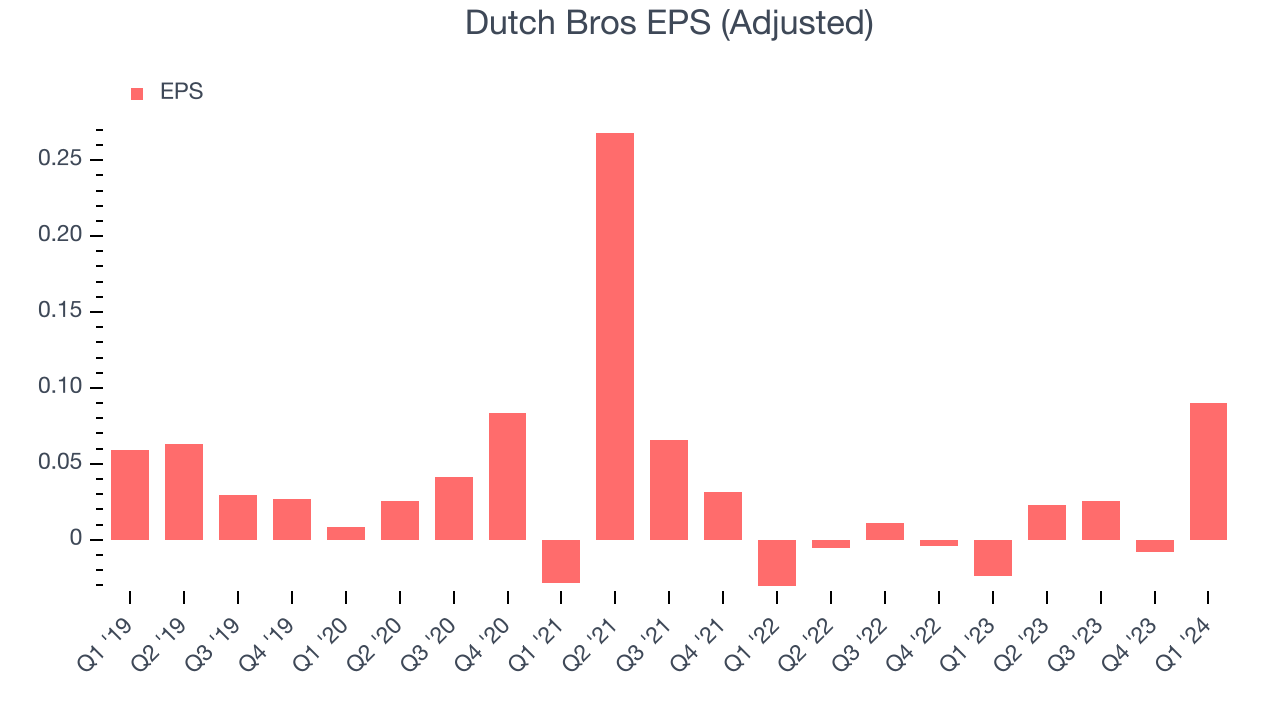
Between FY2020 and FY2024, Dutch Bros's adjusted diluted EPS grew 2.7%, translating into a weak 0.7% compounded annual growth rate.
On the bright side, Wall Street expects the company to continue growing earnings over the next 12 months, with analysts projecting an average 137% year-on-year increase in EPS.
Return on Invested Capital (ROIC)
EPS and free cash flow tell us whether a company was profitable while growing revenue. But was it capital-efficient? Enter ROIC, a metric showing how much operating profit a company generates relative to how much money the business raised (debt and equity).
Dutch Bros's five-year average ROIC was negative 23.8%, meaning management lost money while trying to expand the business. Its returns were among the worst in the restaurant sector.
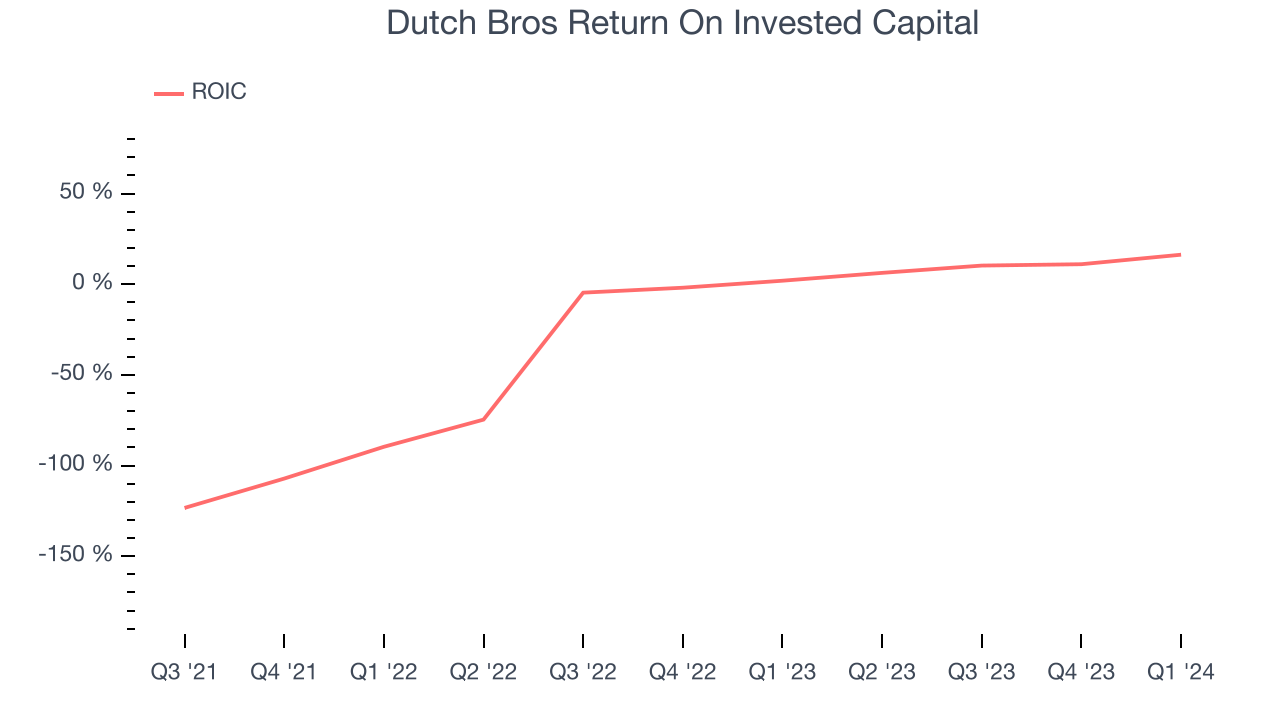
Balance Sheet Risk
As long-term investors, the risk we care most about is the permanent loss of capital. This can happen when a company goes bankrupt or raises money from a disadvantaged position and is separate from short-term stock price volatility, which we are much less bothered by.
Dutch Bros is a well-capitalized company with $262.7 million of cash and $246.2 million of debt, meaning it could pay back all its debt tomorrow and still have $16.53 million of cash on its balance sheet. This net cash position gives Dutch Bros the freedom to raise more debt, return capital to shareholders, or invest in growth initiatives.
Key Takeaways from Dutch Bros's Q1 Results
This was a 'beat and raise' quarter. We were impressed by how significantly Dutch Bros blew past analysts' adjusted EBITDA and EPS expectations this quarter. We were also excited its full year guidance was raised. Zooming out, we think this was an impressive quarter that should delight shareholders. The stock is up 8.7% after reporting and currently trades at $30.9 per share.
Is Now The Time?
Dutch Bros may have had a good quarter, but investors should also consider its valuation and business qualities when assessing the investment opportunity.
Dutch Bros isn't a bad business, but it probably wouldn't be one of our picks. Although its revenue growth has been exceptional over the last four years, its relatively low ROIC suggests it has struggled to grow profits historically. And while its new restaurant openings have increased its brand equity, the downside is its cash burn raises the question of whether it can sustainably maintain growth.
Dutch Bros's price-to-earnings ratio based on the next 12 months is 91.6x. We can find things to like about Dutch Bros and there's no doubt it's a bit of a market darling, at least for some investors. But it seems there's a lot of optimism already priced in and we wonder if there are better opportunities elsewhere right now.
Wall Street analysts covering the company had a one-year price target of $35.33 per share right before these results (compared to the current share price of $30.90).
To get the best start with StockStory, check out our most recent stock picks, and then sign up to our earnings alerts by adding companies to your watchlist here. We typically have the quarterly earnings results analyzed within seconds of the data being released, and especially for companies reporting pre-market, this often gives investors the chance to react to the results before the market has fully absorbed the information.
